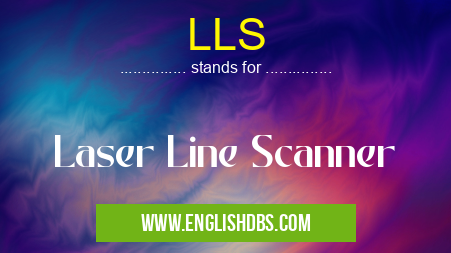What does LLS mean in UNCLASSIFIED
LLS stands for Laser Line Scanner. It is an active 3D scanning technology that uses a laser to project a line of light onto the surface of an object. The reflected light is captured by a sensor, which is used to create a 3D model of the object.

LLS meaning in Unclassified in Miscellaneous
LLS mostly used in an acronym Unclassified in Category Miscellaneous that means Laser Line Scanner
Shorthand: LLS,
Full Form: Laser Line Scanner
For more information of "Laser Line Scanner", see the section below.
Principle of Operation
LLS works by projecting a thin line of laser light onto the surface of an object. The laser line is typically swept across the object in a raster pattern, and the reflected light is captured by a camera. The captured data is then processed to create a 3D model of the object.
Advantages of LLS
- High accuracy: LLS can achieve high accuracy, with resolutions down to a few microns.
- Non-contact: LLS does not require physical contact with the object being scanned, which makes it suitable for scanning delicate or fragile objects.
- Fast: LLS can scan objects quickly, making it suitable for use in automated applications.
- Versatile: LLS can be used to scan a wide variety of objects, including both organic and inorganic materials.
Applications of LLS
LLS is used in a variety of applications, including:
- Reverse engineering: LLS can be used to create 3D models of existing objects for the purpose of design or manufacturing.
- Quality control: LLS can be used to inspect objects for defects or deviations from specifications.
- Medical imaging: LLS is used in medical applications, such as laser scanning microscopy and laser scanning confocal microscopy.
- Surveying: LLS is used in surveying applications, such as mapping and terrain modeling.
Essential Questions and Answers on Laser Line Scanner in "MISCELLANEOUS»UNFILED"
What is a Laser Line Scanner (LLS)?
A Laser Line Scanner (LLS) is a non-contact optical sensing technology that uses a laser beam to generate a thin line of light and a sensor to detect the reflected light from the scanned surface. The resulting data provides highly accurate 3D measurements of the scanned surface.
How does an LLS work?
An LLS emits a laser beam onto a surface, and a sensor captures the reflected light. By triangulating the angle between the emitted beam and the reflected light, the sensor can calculate the distance between the scanner and the surface at each point along the line. This data is then used to generate a 3D point cloud representing the scanned surface.
What are the advantages of using an LLS?
LLS technology offers several advantages, including:
- High accuracy: LLS systems can achieve sub-millimeter accuracy in 3D measurements.
- Fast data acquisition: LLS systems can scan large surfaces quickly, making them suitable for high-speed applications.
- Non-contact measurement: LLS systems do not require physical contact with the scanned surface, making them ideal for delicate or moving objects.
- Versatility: LLS systems can be used for various applications, including reverse engineering, inspection, and robotics.
What are the limitations of an LLS?
LLS technology has some limitations to consider:
- Sensitivity to ambient light: LLS systems can be affected by strong ambient light, which can interfere with the detection of reflected light.
- Limited scanning range: LLS systems have a limited scanning range, typically a few meters.
- Surface reflectivity: The accuracy of LLS measurements can be affected by the reflectivity of the scanned surface.
What are the applications of an LLS?
LLS systems are used in various industries and applications, such as:
- Manufacturing: Reverse engineering, quality control, and assembly guidance
- Robotics: Object recognition, navigation, and manipulation
- Healthcare: Medical imaging, surgical planning, and prosthesis design
- Architecture and construction: Building documentation, renovation planning, and site surveying
Final Words: LLS is a powerful 3D scanning technology that offers high accuracy, non-contact scanning, and versatility. It is used in a wide variety of applications, including reverse engineering, quality control, medical imaging, and surveying.
LLS also stands for: |
|
| All stands for LLS |
